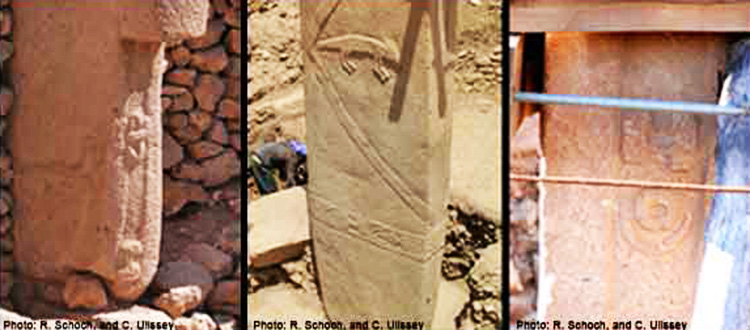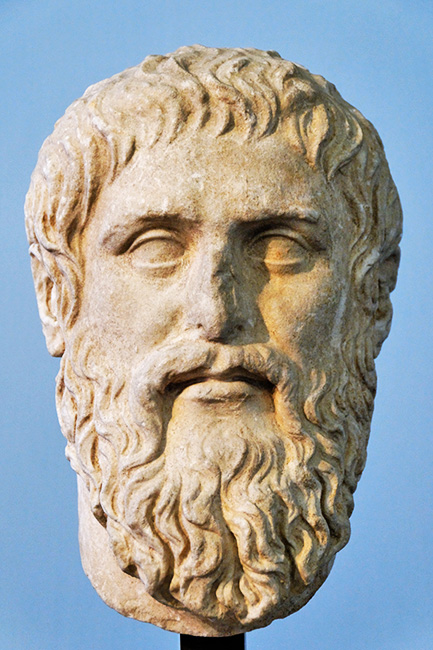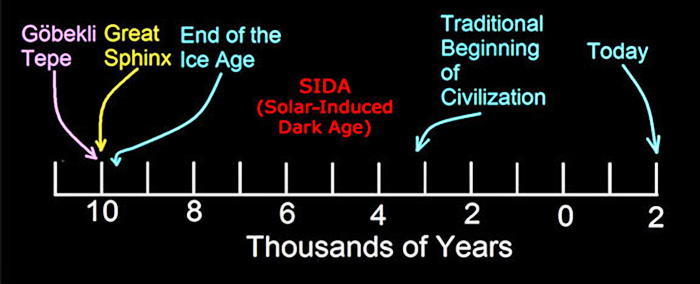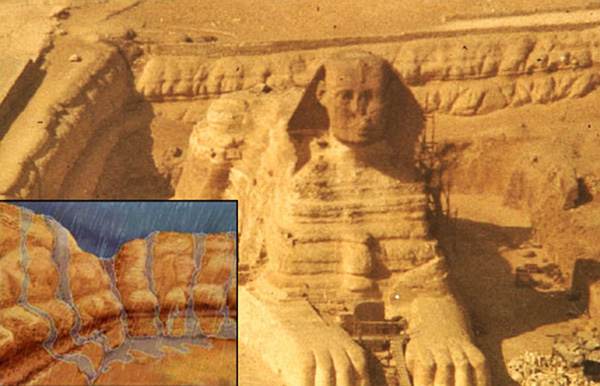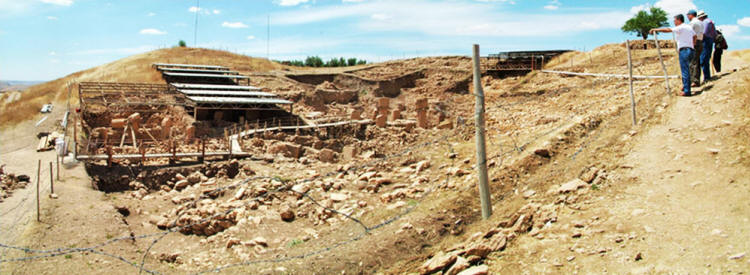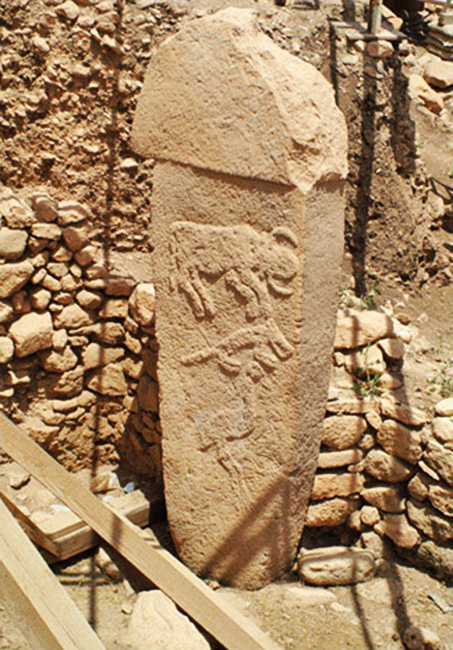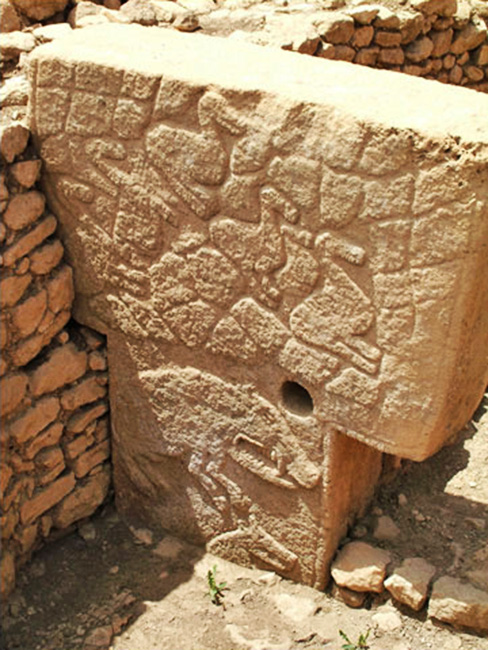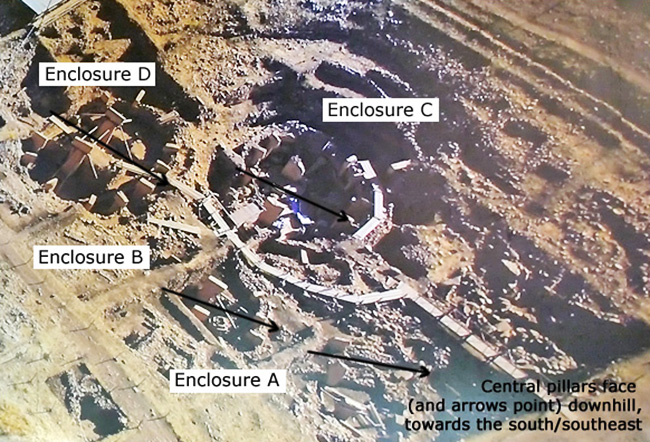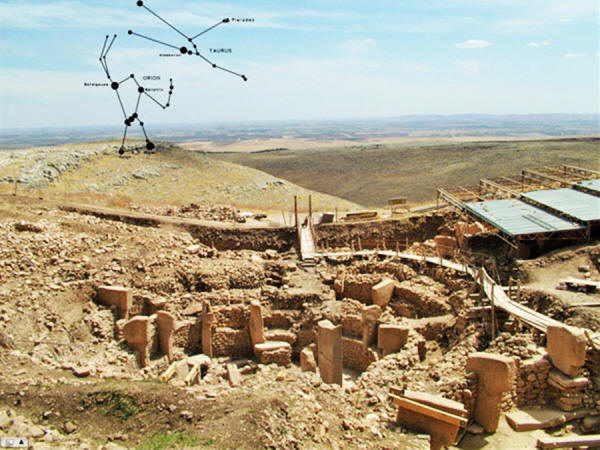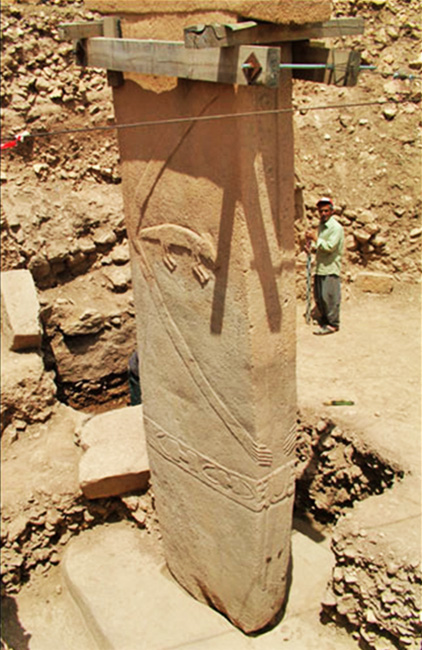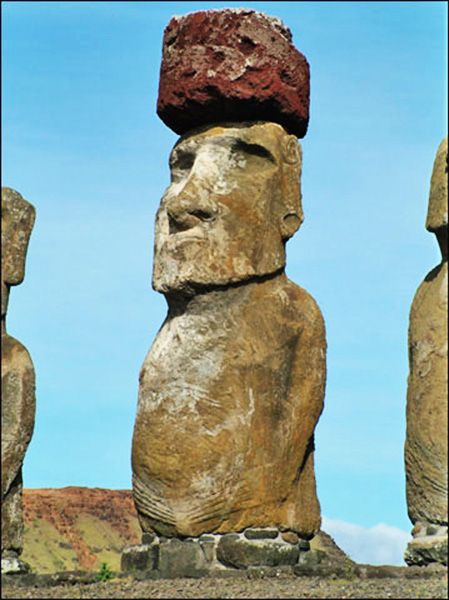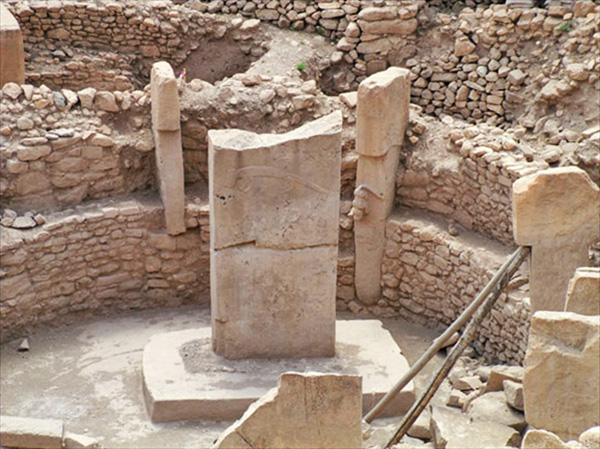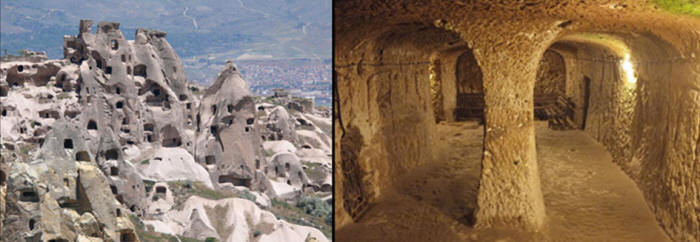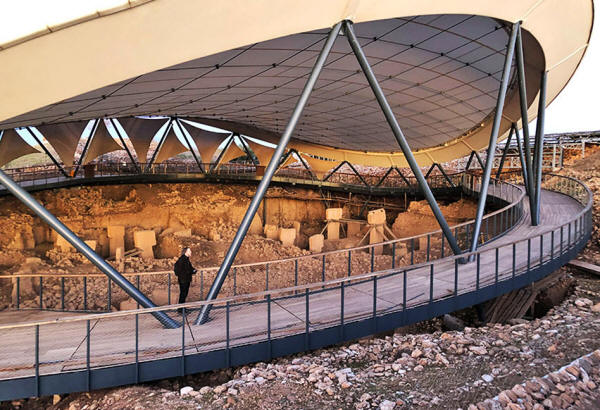|
by Robert M. Schoch
To this day the popular conception, both among the public and as promulgated by many historians and archaeologists, is that of small, primarily nomadic, bands of people perpetually on the brink of existence, endlessly in pursuit of their next meal.
The words of the philosopher Thomas Hobbes (1588-1679) still resonate in expressing this myth:
That is, humans were mere hunters and gatherers foraging for food.
The technology of the time was primitive, characterized as "stone age". Social institutions were minimal. In warmer climates people could go naked, whereas in colder climates they wrapped themselves in animal skins and huddled in caves.
According to the standard
paradigm, as espoused by the great archaeological synthesizer V.
Gordon Childe (1892-1957), this all changed with the domestication
of plants and animals and the development of agriculture, which
ultimately led to the first great civilizations taking root in such
regions as Mesopotamia and Egypt around 5000 to 6000 years ago.
There is another, much older, view found among the classical ancients - including the Greeks, the Romans, and the dynastic Egyptians - which is encapsulated in the legend of Atlantis as recounted by Plato (ca. 429-423 to ca. 348-347 BCE).
The core of the Atlantis story is that a high culture, a true civilization, existed thousands of years prior to the most recent flowering of civilization, circa 4000 BCE to 3000 BCE. Furthermore, this earlier civilization was destroyed cataclysmically by natural events, including the island nation of Atlantis being enveloped by the ocean waters (that is, it was flooded).
Most interestingly, Plato gives a precise chronology which, when translated into our modern system of dating, places the fall of Atlantis at circa 9600 BCE - tantalizingly close to the end of the last ice age circa 9700 BCE, as determined by modern geological techniques.
Luni marble, copy of the portrait made by Silanion ca. 370 BC for the Academia in Athens.
Photo
courtesy of Marie-Lan Nguyen, 2009.
Around the globe there are ancient and indigenous legends of early advanced peoples, civilizations, that existed thousands of years ago (thousands of years prior to the latest flowering of civilization beginning about 5000 to 6000 years ago).
These early societies and civilizations were subsequently destroyed by natural cataclysms.
The dynastic Egyptians two thousand years prior to Plato spoke of an epoch they referred to as Zep Tepi, or the "first time", a "golden age" of civilization.
Such stories, be they framed in terms of Atlantis, Zep Tepi, or Judeo-Christian Biblical pre-deluge humanity, are disparaged and offhandedly dismissed by many modern academics.
But the hallmark of good science and scholarship is to always stick with the evidence, following it wherever it may lead, whether or not it contradicts the popular paradigm of the day.
In a sense, both,
...may be correct.
However, this early cycle
of civilization was dealt a mighty setback; it was utterly
devastated, with only a few isolated remnants surviving, by the
natural cataclysms that brought the last ice age to a close, circa
9700 BCE.
A dark age ensued, which I refer to as SIDA (solar-induced dark age). 3
For thousands of years following the end of the last ice age humanity was reduced to the brutish Hobbesian state - hunting, foraging, and eking out a hardscrabble existence; and this included living in caves in some regions.
Indeed, retreating to caves and other underground shelters would have been a way for isolated pockets of humanity to survive the cataclysmic solar-induced onslaughts at the end of the last ice age...
Thus during the millennia prior to the latest cycle of civilization, beginning circa 5000 to 6000 years ago, humanity was in a primitive stone age state, as the conventional paradigm holds, except that this state was due to a decline from an earlier and more advanced state.
After a time lag of millennia, civilization as we know i, arose from the literal ashes of SIDA (Solar-Induced Dark Age).
and the
reemergence of civilization.
For many years I literally would not even voice the word "Atlantis" in public for fear of being mocked by my academic peers.
Why did I change my opinion?
My announcement was done via a presentation at the October 1991 annual meeting of the Geological Society of America (this was allowed only after a formal abstract, submitted with my colleague John Anthony West, was accepted based on positive professional peer review). 4
I made my case utilizing scientific analyses, comparing erosion and weathering profiles around the Sphinx to the ancient climatic history of Egypt.
In brief, the Sphinx sits on the edge of the Sahara Desert, a hyper-arid region for the past 5000 years; yet the statue shows substantial rain-induced erosion.
The original structure
must date back thousands of years prior to 3000 BCE (the head was
re-carved in dynastic times).
with an illustration showing the deep fissures and undulating surfaces created by water (rainfall) weathering.
People 7000 or more years ago were still brutish and unsavory, at least by modern civilized standards. Certainly they were not carving giant statues (the Sphinx is about 20 meters tall by over 70 meters long) out of solid limestone bedrock.
Immediately after my announcement of an older Sphinx, I was under attack.
Archaeologist Carol Redmount (University of California, Berkeley) was quoted in the media,
The article continued,
The initial hoopla peaked in February 1992 at a "debate" on the age of the Great Sphinx held at the Chicago meeting of the American Association for the Advancement of Science. 6
As the New York Times put it,
Egyptologist Mark Lehner could not accept the notion of an older Sphinx, personally attacking me by labeling my research "pseudoscience."
Lehner argued,
At the time I lacked any pottery shards.
But I was sure of my science, and I persisted.
Decades later, we have something better than pottery shards, and even earlier than my conservative Sphinx date of circa 7000 BCE to 5000 BCE.
(I now currently posit, based on additional evidence and a reanalysis of my original data, that the core body of the Great Sphinx dates back to the end of the last ice age; the head was re-carved in dynastic times).
Göbekli Tepe dates back approximately 12,000 years ago...
(from the southeast looking northwest); photos taken in 2010, before this area of the site was covered with a modern roof.
In 1995 the late Prof. Dr. Klaus Schmidt of the German Archaeological Institute began excavating the site. 8
In 2010 I first visited it for myself. I was amazed...
First pillar found by the landowner (the top was broken as he
endeavored to plow his field).
The workmanship is extraordinary, with clear sharp edges that would do any modern mason proud. It may be a cliché, but I cannot help but think of the opening scene of the classic 1968 movie 2001 - A Space Odyssey:
Various pillars at Göbekli Tepe are decorated with bas-reliefs of animals, including foxes, boars, snakes, aurochs (wild cattle), Asiatic wild asses, wild sheep, birds (cranes, a vulture), a gazelle, and arthropods (scorpion, ants).
The carvings are refined, sophisticated, and beautifully executed. Not only are there bas-reliefs, but also carvings in the round, including a carnivorous beast, possibly a lion or other feline, working its way down a column, apparently in pursuit of a boar carved in relief below.
In the round carvings of lions and boars have been uncovered, now housed in the Museum of Şanlıurfa, as is a life-sized statue of a man, which, though from Urfa, apparently dates to the Göbekli Tepe era.
Also from Göbekli Tepe are perfectly drilled stone beads. And, according to Prof. Schmidt, while some of the stone pillars were set in the local bedrock, others were set into a concrete-like or terrazzo-like floor.
Looking only at the style and quality of workmanship, one might easily suggest that Göbekli Tepe dates between 3000 and 1000 BCE.
Based on radiocarbon analyses, the site goes back to the period of 9000 to 10,000 BCE (or possibly earlier), and was intentionally buried by no later than circa 8000 BCE. 10
That is, the site dates
back an astounding 10,000 to 12,000 years ago...!
Clearly there is a disconnect between what conventional historians and archaeologists have been teaching all these years and the clear evidence on the ground.
As Stanford University archaeologist Ian Hodder commented, Göbekli Tepe is,
Like my re-dating of the
Great Sphinx, Göbekli Tepe forces us to reconsider our antiquity.
Patrick Symmes wrote in Newsweek,
detailed relief carvings; image also shows abutting
secondary surrounding walls.
What happened...?
Astronomy is often considered the earliest yet most sophisticated of the sciences. A particularly subtle astronomical phenomenon, the discovery of which is generally credited to Hipparchus of Rhodes in the second century BCE, 13 is the slow movement of the stars relative to the Sun (the rising and setting points of non-circumpolar stars change with time).
Known as precession, the entire cycle, with stars returning to their "starting points", takes somewhat under 26,000 years.
Some researchers suggest that precession was known to the ancient Egyptians and other early civilizations, and is reflected in myths worldwide. 14
Others dispute such
assertions. I found evidence of precession at Göbekli Tepe, adding
another layer of sophistication to this remarkable site.
Additional, later and smaller, pillars and structures have been partially uncovered both 20 to 30 meters north and about 80 meters west of the major area of circles, 15 and eighteen or more stone circles still under the earth have been identified.
The enclosures are very close to each other, almost abutting.
Each enclosure possesses a pair of tall central parallel pillars ringed by a circle of shorter pillars with later stonewalls between the pillars.
If at some point the
enclosures were covered over, they may have been entered from above;
indeed, possible carved stone "portals" have been found that may
have been set in a roof.
The central pillars of Enclosure D include arms and hands, with the hands holding the belly or navel area, and it is clear that the anthropomorphic pillars are facing south.
The orientations vary from enclosure to enclosure, however.
These varying angles suggest the builders were observing stars and building new enclosures oriented progressively toward the east as they followed particular stars or star clusters over hundreds of years.
on display at the new Urfa Museum. Arrows indicate approximate midpoints of the central pillars in each enclosure. For more accurate diagrams, please see Dr. Schmidt's published papers (copyrighted) as well as images further below showing the precise positioning of the central pillars
into
their foundations.
This is a difficult question to answer, but we can hypothesize.
On the morning of the Vernal Equinox of circa 10,000 BCE, before the Sun rose due east at Göbekli Tepe,
...were in view in the direction indicated by the central stones of Enclosure D, with Orion's belt not far above the horizon (as seen from the best vantage points in the area) as dawn broke. 17
A similar scenario played out for the orientation of the central stones of Enclosure C in circa 9500 BCE and for Enclosure B in circa 9000 BCE...
Enclosure A is oriented toward the Pleiades, Taurus, and Orion on the morning of the Vernal Equinox circa 8500 BCE, but due to precessional changes, the entire belt of Orion no longer rose above the horizon before dawn broke.
These dates fit well the timeframe established for Göbekli Tepe on the basis of radiocarbon dating.
looking slightly southeast towards the horizon (photo take in 2010, before the area was roofed). The illustrations of Orion and Taurus
are
rough approximations.
I suspect that these traditions go back to Göbekli Tepe times, and even earlier...
showing anthropomorphic features (arms, hands, animal nestled in the elbow joint, belt with symbols, fox-pelt loincloth);
photo
taken in 2010.
Researchers such as Michael Rappenglueck, Frank Edge, and Luz Antequera Congregado have identified the constellation Taurus and the Pleiades among the paintings of Lascaux cave, France, dating back 16,500 years ago. 18
Additionally, Rappenglueck asserts that a tiny tablet from Germany, carved of mammoth ivory and dating back at least 32,500 years, depicts the constellation Orion in the familiar guise of a narrow-waist male with outstretched arms and legs. 19
Given such evidence, it is reasonable that the Göbekli Tepe people recognized Orion as a human figure, even as a hunter.
The mammal remains found while excavating Göbekli Tepe (including numerous gazelle, aurochs or wild cattle, wild ass, fox, wild sheep/goat species, and boars), as well as the reliefs on the pillars, can be taken to indicate a hunting society.
Indeed, studying the anthropomorphic pillars of Enclosure D, they may represent, in stylized form, Orion.
Not only do they have arms (which could be interpreted as the arms of Orion brought down to the body), but also prominent belts (the belt stars of Orion), and a fox or dog-like creature nestled in the arm of one pillar, which could represent Sirius, the Dog Star.
Just as Orion travels with his companion, Sirius, so too do the Göbekli Tepe pillars.
Yes, I do believe this could be the case.
Furthermore, the central pillars of Enclosure D have fox pelt loincloths that may possibly represent the Orion Nebula and associated features.
However, if the fox pelt loincloth does represent the Orion Nebula, this may be a remembrance of a feature that was visible above the horizon circa 12,000 BCE and earlier at Göbekli Tepe, as it no longer appeared above the horizon during the period of 10,000 to 8000 BCE at Göbekli Tepe.
Or, it may be that the
Göbekli Tepe people knew of this feature from viewing Orion at more
southern latitudes, such as in the area of Giza, Egypt, where the
Orion Nebula rose above the horizon circa 10,000 to 8000 BCE.
If they were observing stars (versus the Sun, for instance), then they needed to readjust their observations over the centuries due to precessional changes.
And maybe they were observing something more than just the Sun, Moon, planets, and stars.
with
hands to the navel region.
I believe these similarities are real, but I might have missed them if I had not been to both sites in succession.
Furthermore, both Easter
Island and Göbekli Tepe may relate to powerful
electrical discharge
plasma events in the skies at the end of the last ice age.
Amazingly, both the moai and the anthropomorphic central pillars of Enclosure D at Göbekli Tepe have arms and hands positioned similarly against the body, with hands and fingers extended over the belly and navel region.
The moai are looking up at the skies, and I believe the Göbekli Tepe pillars are also looking towards the skies.
As I have discussed elsewhere, 20 the indigenous Easter Island rongorongo script may record, or have been inspired by (the surviving rongorongo tablets are assuredly recent, being copies of copies of copies...), a major plasma event in the skies thousands of years ago, at the end of the last ice age.
Plasma consists of electrically charged particles.
Los Alamos plasma physicist Anthony L. Peratt and his associates have established that petroglyphs found worldwide record an intense plasma event (or events) in prehistory. 21
Peratt has determined that powerful plasma phenomena observed in the skies would take on characteristic shapes resembling humanoid figures, humans with bird heads, sets of rings or donut shapes, and writhing snakes or serpents - shapes reflected in the ancient petroglyphs.
Plasma events may be a
dominant theme found among the ancient remains of Easter Island.
Likewise, plasma may be important to understanding Göbekli Tepe.
Furthermore, before its final burial, stonewalls were built between the finely wrought pillars. These walls are, in my opinion, clearly secondary as in many cases they cover over the fine relief carvings on the pillars. They are also much cruder than the pillars.
Additionally, some pillars appear to have fallen over and broken, and were subsequently repaired or re-erected when the walls were built.
In several cases the bases of the broken pillars are missing or lying horizontally under the tops of the broken pillars that were set to the correct height on a pile of stones.
At this late stage the walls and pillars may have been roofed over.
Forgotten Civilization: The Role of Solar Outbursts in Our Past and Future by Robert Schoch (Plasma and petroglyph illustrations courtesy of Dr. Anthony L. Peratt, reprinted with permission from IEEE Transactions on Plasma Science,
December 2003, volume 31).
These stone "houses" of Easter Island are similar to the structures formed by the walls and pillars of Göbekli Tepe.
Some might criticize comparisons between Easter Island and Göbekli Tepe not only on the basis that they are on opposite sides of the globe, but are also ostensibly separated by thousands of years (Göbekli Tepe dating from 8000 BCE and before, whereas according to standard chronologies Easter Island was not inhabited until a mere millennium and a half ago).
In counterargument, I question whether we really know when Easter Island was first colonized.
Even if surviving Easter Island antiquities and structures are from a relatively late period, they may reflect earlier traditions and styles, perhaps brought by settlers from elsewhere, that date back to a time of intense plasma outbursts.
The rongorongo tablets
may carefully preserve ancient texts that were copied over and over.
Peratt has made the connection between birdman petroglyphs and plasma phenomena around the world. On Easter Island we find birdman petroglyphs as well as birdmen and bird symbols among the rongorongo hieroglyphs.
At Göbekli Tepe a very similar bird form was carved into one of the pillars.
Peratt records many plasma phenomena that can be interpreted as having the appearance of snakes. Numerous "snakes" are found on the pillars of Göbekli Tepe, slithering vertically up and down the ends of some of the columns.
Could these represent huge bolts of plasma?
In my book Forgotten Civilization 22 I have made the case that a major plasma event, circa 9700 BCE, brought about the end of the last ice age.
Based on the radiocarbon dating, some of the structures at Göbekli Tepe are contemporaneous with the end of the last ice age.
Enclosure D in particular was initially erected prior to 9700 BCE, but suffered damage (indicated, for instance, by a toppled and subsequently re-erected pillar) during the cataclysmic activity that brought the ice age to an end. At this time the earliest crude secondary walls were erected between the pillars.
Later stone pillars and enclosures were erected during the early period of turmoil just after the ice age ended, and ultimately the entire site of Göbekli Tepe was artificially buried (perhaps to protect it?) under a mountain of dirt and debris.
showing (at ground level) the precise positioning of the central pillars into their foundations. Also evident in the photo (from 2010) are the secondary walls supporting the outer/surrounding pillars, and in some cases serving to prop up and reposition the broken pieces of toppled pillars
(suggesting the importance of their positioning).
In terms of material artifacts, primarily large megalithic structures from pre-SIDA times remained. Pockets of humanity survived in isolated spots where the natural geography and resources were relatively hospitable.
A good example is the
Cappadocia region of modern Turkey where the soft volcanic bedrock
was conducive to the excavation of extensive underground shelters
and indeed entire cities, providing protection from the occasional
solar outbursts that most likely continued for centuries or
millennia after the close of the last ice age, somewhat analogous to
the aftershocks following a large earthquake.
in the Cappadocia region of Turkey (some of the underground cities are estimated to have at one time each sheltered tens of thousands of people, small animals, etc.).
at sunrise in January 2020.
The
view is looking toward the northwest.
Endnotes
|


